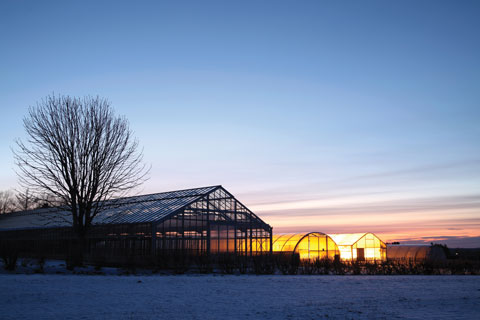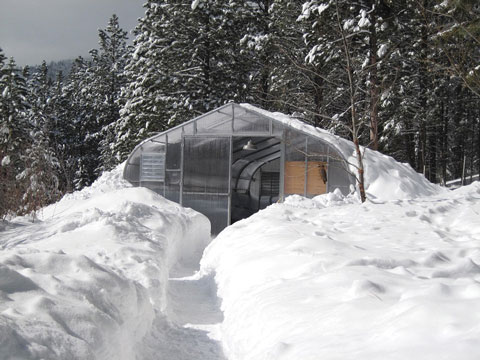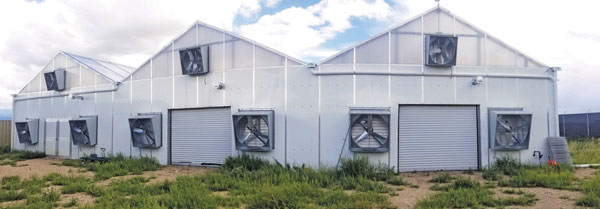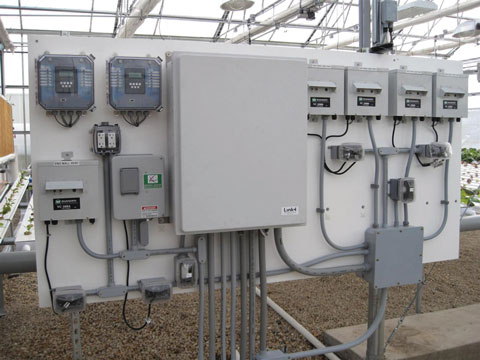4/1/2022
Optimizing Heating in Your Winter Greenhouse
Patrick Mahoney

In many regions, growers don’t have to worry about the burden of snow or having to use a greenhouse heater to cultivate year-round. Not everyone is afforded this luxury, though, and for cold-climate growers, a winter greenhouse offers a lifeline to stay competitive by enabling them to grow uninterrupted. Still, success can fluctuate greatly from operation to operation.
Pictured: When planning to grow throughout the winter, it’s critical for the greenhouse’s design and R-value to be optimized.
There are a number of factors that influence performance in a winter greenhouse and growers often have to consider the smallest details when they prepare their operation for cold weather. To keep production at the highest level, without breaking the bank on utility costs, growers must lay out an effective winter growing strategy.
Primarily, growers should first understand the basics of optimizing heating in their winter greenhouse. This includes knowledge of the various factors that influence heating, different types of greenhouse heaters, as well as how a structure’s design impacts production.
Understanding BTUs and R-value
As it is, there are a number of calculations you have to make to maximize production. The looming threat of cold weather only adds to the complications, forcing growers with a winter greenhouse to do some extra problem solving.
The first equation to understand in optimizing heating is solving how many BTUs are required to sufficiently heat a winter greenhouse. A BTU, or British Thermal Unit, is a unit of heat and is defined as the amount of heat required to raise the temperature of 1 pound of water by one degree Fahrenheit. Calculating the needed BTUs will determine the appropriate size for an operation’s greenhouse heater.
To solve how many BTUs are needed for a specific winter greenhouse to be heated, you can follow this formula: (Desired Temperature Change) x (Cubic Feet of Space) x .133 = BTUs needed per hour
 Pictured: By adding an efficient heat source, winter greenhouses can maintain their interior temperature while keeping utility costs to a minimum.
Pictured: By adding an efficient heat source, winter greenhouses can maintain their interior temperature while keeping utility costs to a minimum.
Every operation’s winter greenhouse will vary in size and require different temperature changes to function properly, so the numbers to fit this equation will almost always vary. Still, it’s the starting point for you in sizing an effective greenhouse heater system.
Determining the size of a greenhouse heater system is an important first step for growers, but any efforts to heat properly will be nullified without also understanding R-value. R-value represents a cladding’s thermal resistance, which impacts how effective a winter greenhouse is at retaining heat. It’s important for you to understand how to calculate heat loss so you can choose the best cladding for your greenhouse and maintain optimal heating efficiency.
Heat loss can be calculated by using the following formula: Q = A(Ti-To)/R
In this equation, A is the area of the winter greenhouse, while Ti and To represent the indoor and outdoor temperatures. The R symbolizes a cladding’s R-value, and with a higher number in R, Q results in a lower number, meaning fewer BTUs lost per hour.
While a greenhouse heater works to supply BTUs in a winter greenhouse, the cladding keeps that heat in. Understanding the relationship between these two factors will help you make informed decisions about your winter greenhouse, which can aid you in keeping utility costs down and ensuring valuable heat doesn’t escape your structure.
Choosing the right greenhouse heater
Sizing out a greenhouse heater is critical to your budgets, as well as the health of your plants. To truly optimize heating, though, you also need to understand the fundamental differences between various greenhouse heaters and choose a high-efficiency option that can save you money while still being effective.
The two most common types of greenhouse heaters are gas and electric greenhouse heaters. Gas greenhouse heaters typically employ propane or natural gas, and are commonly used because of their relatively lower cost and high productivity. They’re also convenient for growers who don’t have access to electricity, although this is uncommon in larger commercial operations.
Gas heaters, however, emit fumes into the air, which can be an issue in a winter greenhouse that’s sealed up to prevent heat loss. Without proper ventilation and air circulation, these fumes can cause issues for both plant and worker health.
 Pictured: By implementing the right cladding, growers can raise their structure’s R-value and improve its heat retention, helping to reduce the operation’s overall heating requirements.
Pictured: By implementing the right cladding, growers can raise their structure’s R-value and improve its heat retention, helping to reduce the operation’s overall heating requirements.
Electric greenhouse heaters generally offer a better solution for a winter greenhouse, as they don’t emit the same fumes and don’t require a natural gas line or consistent fuel supply. Electric greenhouse heaters work well with programmable thermostats or environmental controllers, meaning they can be more easily automated.
Greenhouse heating tips
With both types of greenhouse heaters, a high-efficiency model can keep production at the highest level possible. By adding an efficient heat source, winter greenhouses can maintain their interior temperature and keep even the warmest-climate crops healthy, all while keeping utility costs to a minimum.
One of the best high-efficiency greenhouse heaters available is the Modine Effinity 93 Condensing Unit Heater. Although this is a gas greenhouse heater, it’s 93% efficient, so growers can benefit from substantial energy savings during the cold season.
It provides uniform wall-to-wall temperatures and consistent air circulation, creating a safe haven for plants from the cold and reducing the emergence of mold with constant air movement. With the improved air circulation and a method of ventilation for the fumes, this greenhouse heater gives cold-climate growers a viable solution for winter production.
Winter greenhouse design
When it comes to retaining heat inside a winter greenhouse, it’s critical to focus on the structure’s design and increase its R-value. Design optimization will help you get the most out of your greenhouse heater, which will be important to your budget.
Although engineering shouldn’t be overlooked, the most significant design component for a winter greenhouse is far and away its cladding. The right cladding will provide enough insulation to help your production thrive during the colder months and keep you growing high-quality plants.
Air can be an excellent insulator in a winter greenhouse and presents a number of possibilities for growers. From higher-end cladding to more budget options, many types of cladding use air to provide structures with added thermal resistance.
For growers with the capability to retrofit their winter greenhouse with new cladding, an excellent year-round option is twin-wall polycarbonate. In 8-mm thickness, twin-wall polycarbonate possesses an R-value of 1.72, one of the highest for greenhouse cladding.
 Pictured: To get the most out of greenhouse automation, growers can incorporate a smart controller that ties all their equipment together and streamlines the entire operation.
Pictured: To get the most out of greenhouse automation, growers can incorporate a smart controller that ties all their equipment together and streamlines the entire operation.
The spaces between the two layers of polycarbonate trap air, creating air pockets that help keep heat from escaping. Its thermal resistance makes it a popular choice among growers in northern climates and it far outweighs other cladding options, like single-layered film, which provides an approximate R-value of just 0.83.
Since this may not be a viable option for all growers, there are other effective solutions to increasing heat retention without upgrading to a higher-end cladding.
One solution is double poly film, which uses air to create a well-insulated structure at a fraction of the cost of other cladding options. This cladding utilizes a small compressor to inflate the space between two layers of film, where it captures air to create a buffer between the structure’s interior and the outdoors. As a more cost-effective choice, double poly film can provide an R-value of up to 1.5, creating valuable insulation for a winter greenhouse.
Without replacing cladding, there are other, more creative ways to increase a winter greenhouse’s thermal resistance. Improving insulation will help prevent heat from escaping and provides valuable assistance to a grower’s greenhouse heater.
An easy way to bolster insulation is with a material like TekFoil Reflective Foil, which works to reduce radiant heat transfer across open spaces, a primary contributor to winter heat loss. This helps you to ensure heat isn’t leaking from your winter greenhouse without costing a fortune.
Another effective method for increasing heat retention is installing energy curtains inside a structure. By deploying energy curtains across the roof as the sun goes down, you can create a thermal barrier that traps heat and keeps your winter greenhouse warmer throughout the night when outside temperatures are at their lowest. Energy curtains can also decrease the amount of space that needs to be heated, which is helpful for your greenhouse heater and your subsequent energy costs.
Finding the right setup in a winter greenhouse can be time consuming, but proper preparation is necessary to thrive through the cold season. GT
Patrick Mahoney works for GrowSpan Greenhouse Structures. For over 40 years, GrowSpan has been providing the horticulture industry with high-quality growing structures. For more information, visit www.GrowSpan.com.